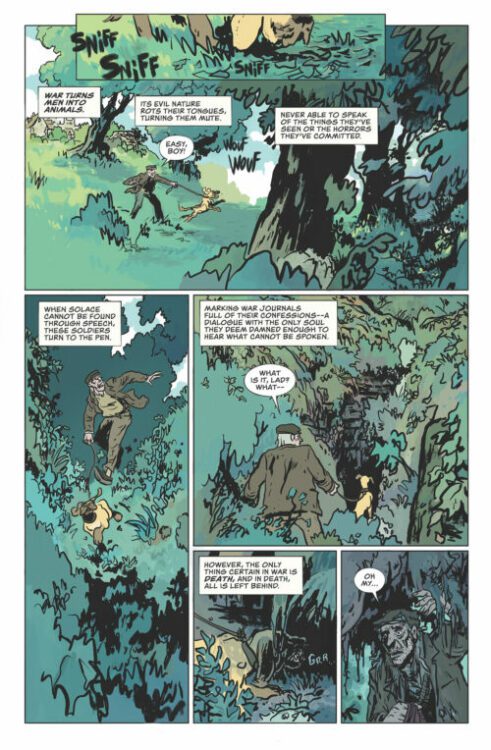There are many stories about the First World War. Narratives filled with soldiers marching, fighting, dying. And every genre has been mixed into the war story over time, in order to give different accounts of one of the worst periods in human history. It’s difficult to believe that there are still new stories to tell. But of course there are, and—as the new graphic novel Hound from Mad Cave Studios demonstrates—there are still some very powerful tales to draw from the horrific conflict.
So, sit back, put on some haunting music, possibly by the late great Ennio Morricone, and fall into the unnerving and moving world of Hound. It’s not what you expect it to be.

Credit: Mad Cave Studios
In 1917, a fresh faced young Private named Barrow is enlisted to join a select team of soldiers because of his unique work experience in the sewers of London. The elite squad, known as The Hounds, work in the worst parts of the battlefields, separate from the army and surrounded by the empty, poisonous gas ravaged wastelands. Once away from the commanders, in isolation, Barrow begins to learn that war can change a person. What is accepted as normal behaviour no longer applies and the distinction between Man and Beast becomes hazy and almost lost.
One of the first things that you notice about the comic is Rodrigo Vasquez’ art style. The cartoon characters, with their exaggerated features, inhabit expressionistic worlds made of colour and shapes. The sets are built from these shapes, locations indicated at by the colours. The depth of a forest is symbolised by the density and shade of greens just as the violent battlefields are illustrated by the darkening purples and misty greys. As the comic progresses, the atmosphere is created by the shifts in colour, the locations become dangerous because of the darkness or the uncomfortable shapes of red and purple.
Vasquez’ style is very European, and the images in the panels resemble a classic Bande Dessinee such as The Adventures of Tintin and the work of French cartoonist Tignous, whose illustrations for the card game The Grizzled have a very similar aesthetic. The characters have exaggerated features making them instantly recognisable from page to page, but the beauty of Vasquez’ work is that even as the characters change, they retain an element of themselves. For example, when we are introduced to the young Barrow in a flashback, he is instantly recognisable on the page, before any of the text is read.

Credit: Mad Cave Studios
Another aspect of the art work that lends itself to this particular comic is the emotions that Vasquez builds into each of the characters and their physical appearances. This allows the emotional aspects of the narrative to be more impactful. As a reader, you are pulled into this disturbing and desolate world of war along with Barrow, feeling the fear that he feels—the revulsion and the trauma. Barrow’s experiences are life changing and the impact is portrayed on the page. The impact of the narrative is so strong, I audibly gasped at several points while reading.
Hound has a powerful voice, one that unravels through the narrative but is visualised by letterer Justin Birch. The lettering is an important element of any comic, but Birch goes above and beyond here. The diary entries have a large part to play, and they look and read like handwritten words. They create a connection between character and reader, one that heightens the emotional bond that you have with Barrow. But this is just one element of the lettering. The sound effects, the guttural screams, and the different languages and accents are all treated with the same care and precision as the diary entries. When a character whispers, you can tell they are whispering, when they scream, their voice shrieks from the page.

Credit: Mad Cave Studios
Writers Sam Freeman and Sam Romesburg have between them captured a disturbing impression of war and laid it at the readers feet, warts and all. They show the horrible effects that conflict can have on people, innocent and guilty alike. Every character suffers in this comic and this makes the poignant moments even more moving. It is a tragedy written in poetic language, like a description of a dying flower. The horror makes the moments of beauty more memorable and the central character’s journey of self discovery is as enriching as it is disturbing.
The title, the cover, and even several moments in the comic, lead the reader to expect a certain plot twist, an emergence of a supernatural element. But the twist, if that’s what it can be called, is so much more delicious than expected. It is more disturbing and the rest of the story is better because of it. The reader’s expectations are warped and suddenly your understanding of the comic has changed. It is no longer safe, no longer predictable. You enter real horror territory.
I do not have enough praise for this book. I picked it up on a whim, planning to skip through the first few pages, but became enraptured by the story, the art, and the sheer beauty of the storytelling. The pacing throughout is perfect with each page acting as a stanza in a war poem. Some of the highlights of the comic are the silent sequences, devoid of text and speech but as powerful as any of the words. It is a magnificent comic, and one that is dying to be read.
Hound from Mad Cave Studios is due for release in comic shops on February 28th, 2024.

